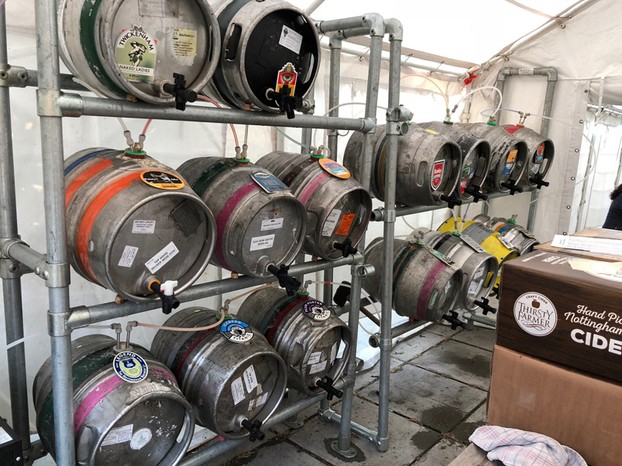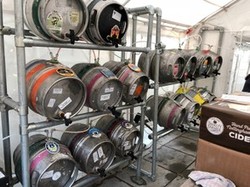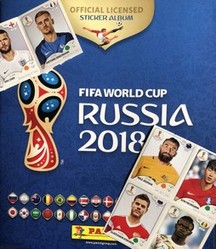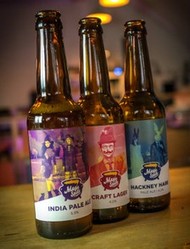Beer and football go together better than anything, and with the world’s biggest football tournament rapidly approaching, Steve Rogerson offers some suggestions about what beers to drink that best match the thirty-two teams that will be playing in the 2018 Fifa World Cup in Russia. What better way to cheer on the teams?

What beers to drink while watching the 2018 Fifa World Cup in Russia
Steve Rogerson suggests some beers to drink while watching the 2018 World Cup in Russia.
 Beer and football were made for each other Photo by Steve Rogerson |
The 2018 Fifa World Cup in Russia is fast approaching. While many fans will be there sampling the local Russian beers before going to the games, for millions of others around the world it will be a case of being glued to their television sets.
But how to watch the action unfold? Snacks, such as nuts, crisps, biscuits and cheese will be welcome, but what is really needed is something with which to wash them down. Beer is the obvious choice, and one of the official sponsors is the American Budweiser brand, but they make pretty awful beer, so why not use the occasion as an excuse to experiment with different beers? Here are some suggestions.
Group A: Russia, Uruguay, Egypt and Saudi Arabia
Though vodka is marginally more popular in Russia, beer is still drunk in large quantities. They also have a good range of light and dark beers. Look out for the Baltika range with numbered bottles, the original lager being number four and the lovely porter number six.
Uruguayan beers are harder to find, but they do have a craft beer scene; the strong 6.3% Davok IPA is recommended and also look out for the Dry Stout from the Montevideo Brew House.
Egypt is known for a beer style called bouza (honestly) and is based on barley and bread, and normally home brewed. Possibly the best-known commercial brew is Stella from a local brewery owned by Heineken, but there are alternatives from Egybev.
You can get beer in Saudi Arabia, but it normally very low or no alcohol. The country’s rulers have already got upset at German brewer Eichbaum putting the Saudi flag on its World Cup special beer. They have since scrapped the Saudi bottle but, if you can get one, that is a must for watching the Saudi Arabian games.
Group B: Portugal, Spain, Morocco and Iran
I do like the Super Bock Abadia from Portugal’s Unicer brewery. This is a rich 6.3% brew. The country also has a wide craft beer range from the likes of Suvina and Musa. Cross the border into Spain for an even wider craft beer range; there are more than 400 craft breweries. I am a fan of the range from the Moska brewery in Girona.
Beer production in Morocco is dominated by the Société des Brasseries du Maroc, the best known of which is a lager called Casablanca, which can be found in other countries. Iran does not do beer.
Group C: France, Australia, Peru and Denmark
France has always been better known for its wine than its beer, but that has been changing over the past decade or so and the country now has a blooming craft beer scene. There is even a so-called trappist beer from the abbey of Sainte Marie du Mont des Cats, however, this is actually brewed by Chimay. Other abbey beers include Brasserie La Choulette's Abbaye de Vaucelles 7.5% beer in the Bière de Garde style and Les Brasseurs de Gayant’s Saint Landelin range.
For Australia, stay away from the Foster’s; it’s rubbish. Widely available through is the nice range of bottled beers from Coopers Brewery. Carlsberg is Denmark’s best-known brewery but while not as bad as Foster’s, avoid if you can. Instead, try to seek out craft beers from the likes of Mikkeller and To Øl.
All the major beer brands in Peru are owned by Backus and its Cusqueña is probably the easiest to find outside of Peru. The country does also host some craft breweries such as Nuevo Mundo and Cerveza Zenith, but good luck in finding them.
Group D: Argentina, Iceland, Croatia and Nigeria
The best-known Argentinian craft brewery is Antares and it does a reasonable range such as a 6.6% IPA and an 8.5% imperial stout. The boring alternatives, but more easy to find, are the Quilmes beers and Schneider from CCU.
There are craft brewers in Iceland, including Lady Brewery, a female-only brewery. Other notables are Bryggjan, Kex Brewing, Malbygg and Segull 67. I particularly like Icelandic Toasted Porter from Einstök with its roasted coffee and chocolate flavours.
The first Croatian beer ever produced was Osječko and is still the country’s most popular, but there a lots of alternatives these days. The craft beer scene started with the opening of Zmajska Pivovara, also known as the Dragon Brewery, which produces a wuzzy (citrusy) 5.3% American style pale ale. For something a bit more traditional, try Križevačko Tamno Pivo, a dark beer with roasted flavours.
Nigeria, of course, has the 7.5% Guinness Foreign Extra stout. Also look out for Bature Brewery, which opened last year after a crowd-funding campaign.
Group E: Brazil, Switzerland, Costa Rica and Serbia
Brazil is the world’s third largest beer market, but nearly all the beers sold belong to AmBev (now part of ImBev), which owns the Antarctica, Bohemia, Brahma and Skol brands. But fear not, there are microbreweries in the country, though they may be tough to find. Eisenbahn is one of the best known, and it does its own version of the Bamberg Rauchbier smoked beer.
There are between 600 and 700 active breweries in Switzerland, and about a third of them only opened in the past five years. And more appeared this year, such as Bierwerkstatt Nordsud, which brews an 8.0% imperial IPA called NordSud 89˚, and Alpenbrauerei Girun, which has a 6.1% IPA and a 5.1% helles.
Serbia has local breweries but three of the biggest are owned by Heineken or Molson Coors. Out of the country’s craft breweries, Kabinet is probably easiest to find outside its borders; look out for its 02 Kolaboracija caramel stout and Olga On Cardamon imperial porter, both at a whopping 10%.
Florida Ice & Farm has for a long time dominated the beer scene in Costa Rica with mass-produced lagers, but the growth in craft beers forced it to set up its craft beer division called La Micro Brewing, no marks for originality. The most widely available craft beer comes from Costa Rica’s Craft Brewing Co, with the 5% Segua red ale particularly popular.
Group F: Germany, Mexico, Sweden and South Korea
Germany is one of the world’s biggest beer producers and has many breweries but sadly due to its stupid purity laws most of them taste the same. That said, good helles or dunkel from most breweries are worth downing while watching football. However, try to be a bit more adventurous and seek out the Schlenkerla Rauchbier, an excellent smoked beer from Bamberg. Also worth looking for are beers from Camba in Seeon-Seebruck and Hausbrauerei Altstadthof in Nuremberg.
Mexico does have more than Corona, Modelo and Sol, but not much more as its craft beer industry is still quite new, with Tempus being the best known. Also look out for beers from Insurgente such as the 7.3% La Lupulosa IPA.
Founded just seven years ago, the Omnipollo brewery in Sweden is worth seeking out, if for nothing else than its 10.5% Siren barrel-aged maple imperial porter. For dark beers, this brewery is a must with a wide variety of stouts and porters.
A law change in 2014 allowed microbreweries to set up in South Korea to challenge the domination of Oriental Brewery (OB) and HiteJinro. One of these is Wild Wave Brewing, which makes a 5.3% sour beer called Surleim and a 5.6% saison called Ruby.
Group G: Belgium, England, Panama and Tunisia
With two of the big beer producers – Belgium and England – in this group, you should have no problems finding something suitable. Belgium, of course, has its wide range of abbey and trappist beers to sample, though most can be hard to find outside the country. The most widely travelled good beers are Duvel and Leffe, though please try to be a bit more adventurous. Avoid the bland lager that is Stella Artois.
England has too many breweries to count with new ones popping up all the time to challenge the big real-ale producers, such as Marston’s and Greene King, though both do make some fine ales. Best, however, to search out some of the smaller breweries, two of my favourites being Flipside and Magpie from Nottingham. If you see something called John Smith’s Smooth, throw it down the sink.
AB InBev subsidiary Cerveceria Nacional Panama brews the popular but poor quality Atlas lager. This is probably the easiest to find but, if you can, seek out something from Casa Bruja Brewing, such as its 8.1% Talingo chocolate milk stout or 6.1% Chivoperro IPA.
Tunisia’s best three known beers are Celtia, 33 Extra Dry and Stella. There have been craft breweries in Tunisia but they have struggled and some closed since the terrorist attacks in 2015 and 2016. You may have to stick with the mass produced if you want to toast Tunisia.
Group H: Poland, Senegal, Colombia and Japan
Poland is known for strong but uninspiring lagers; if you want to get drunk quickly but don’t care about taste, this is the place for you. Some of the better known brands are Tychy, Lech, Żywiec and Warka. However, many do a porter, which can be more interesting, but also very strong. Recently, craft brewers have started to pop up to challenge the status quo, and some come highly recommended, such as Artezan with its 13% Samiec Alfa imperial stout and its 8.0% Dugges Że Ten Teges imperial IPA.
When it comes to Senegal, it is hard to find anything apart from the Société des Brasseries de l'Ouest Africain (Soboa) that basically produces pale lagers such as the 4.2% Bière La Gazelle, which is nothing to write home about. Colombia is a better bet with a mix of big breweries and small craft beer producers. The AB InBev owned Bogatá Beer Company (BBC, no relation) is one of the bigger ones and its Bacatá Blanca is a reasonable 5.0% witbier. For microbreweries, try the range from 3 Cordilleras, such as its 6.47% Belgian imperial porter.
And, finally, Japan, which has a fast growing craft beer industry to compete with its big name brands such as Asahi, Kirin, Sapporo and Suntory. Fairly well travelled is the Hitachino Nest range from Kiuchi Brewery. Its 7.0% Espresso Stout is worth hunting down as is the 7.0% Red Rice Ale, a fruity beer with a bitter finish.
Other World Cup beers
This is just a small selection and there are lots more from the various countries involved. Check out the supermarkets, specialist shops and online retailers for other ideas, and please use the comments box below to tell everyone what you have found. Don’t forget, many breweries will be doing World Cup specials.
You might also like
Panini Official Fifa World Cup 2018 Russia Sticker AlbumSteve Rogerson looks at what stickers are available for the Panini 2018 Fifa ...
Magic Spells Brewery beers put to the testSteve Rogerson puts together a tasting panel to review the three beers from L...






 KZine Issue 31: Review of October 2021 Issueon 11/07/2021
KZine Issue 31: Review of October 2021 Issueon 11/07/2021
 KZine Issue 30: Review of June 2021 Issueon 07/05/2021
KZine Issue 30: Review of June 2021 Issueon 07/05/2021
 KZine Issue 29: Review of February 2021 Issueon 02/23/2021
KZine Issue 29: Review of February 2021 Issueon 02/23/2021
 KZine Issue 28: Review of September 2020 Issueon 10/01/2020
KZine Issue 28: Review of September 2020 Issueon 10/01/2020



Comments
Steve Rogerson, Thank you for practical information, pretty pictures and product lines.
Is it possible that beer is becoming more popular to drink and to make because of the European Union? It nevertheless surprises me the number of countries that don't have the beer traditions that Germany and the United Kingdom have.
It also surprises me that countries such as Egypt, Morocco, Saudi Arabia and Tunisia have beers. Would those businesses be in non-Egyptian, non-Moroccan, non-Saudi Arabian and non-Tunisian hands?